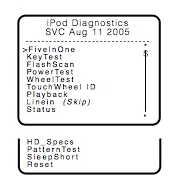Testing the iPod's secret diagnostic tools


I invoked the diagnostic menu by accident. My iPod was very slow to wake up (and it was dark in line at the theater and the backlight had yet to kick in), so I decided to reset it by holding down the Center and Menu buttons simultaneously. For some unknown reason, I pressed the Center and Previous (aka Rewind) buttons a short while latter — don't ask me why, I have no idea. But this latter action did the trick.
Suddenly, I was presented with a list of names under the heading "iPod Diagnostics. According to Methodshop.com, there's a different key combo for entering the diagnostic tools menu with earlier generations of iPod.
For my plain, non-video iPod nano, there are 13 tests and I understand from an iPod technician, as well as from Methodshop's info, that later editions have additional tests.
The scroll wheel isn't supported in this mode, you navigate with the Previous and Next buttons, and start a test with the Center button. A dollar sign in a scrollbar shows where you are in the list. The Menu button returns to the tools menu. (BTW, some Apple documents call the Center button the Action key, which sounds really strange.)
Here's the list of tests on my nano:
Five in One. This runs a number of critical hardware tests (and perhaps the most likely sources of problems), however, for this 4G+ iPod it actually runs 6 tests: CHKSUM (checks the firmware's integrity), Flash memory (runs a check of flash capacity and basic integrity), RTC (checks the clock chip), SDRAM (checks the working memory of the iPod), and USB. So what's the sixth test? If the backlight is on during the test, that shows the backlight is working.
Keytest. Checks the function of the click wheel. It prompts you to click each button and turns their names from gray to black if they pass.
FlashScan. Does a longer scan of the flash memory.
PowerTest. Looks at the battery and other power hardware.
WheelTest. Checks the scrolling capability of the clickwheel.
TouchWheelID. Checks the ID of the clickwheel — no idea that it needed to be carded.
Playback. Checks the headphone out port and makes a loud, annoying tone.
Linein. This is an odd one. Apple must have made a test for some capability of iPods that isn't currently supported or offered.
Status. Hardware information and port status. For example, it lists the serial number and whether the various ports are detected.
HD Specs. Since there's no hard disk on this nano, it's not tested.
PatternTest. A series of patterns and colors test the display performance.
SleepShort. Checks sleep mode.
Reset. Checks the reset function by resetting the iPod — which also stops the test.
After playing around with the diagnostic tool, I ran the reset test and that put me into the usual music menu. All of my music and other files appeared and sounded fine.